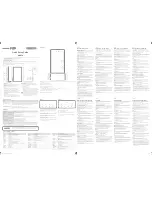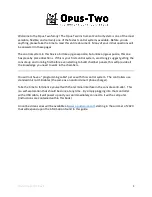
6
FLYNET 100
1.4
Glossary of terms used
The manual uses technical terminology or terminology with different meaning from the common one.
The terms and abbreviations that may be used in the documentation provided are explained below.
DANGER:
a potential source of injury or damage to health;
DANGEROUS ZONE:
any zone inside and/or near the equipment where the presence of an
exposed person poses a risk to the safety and health of that person;
EXPOSED PERSON:
Any person who is wholly or partly in a dangerous zone;
RISK:
a combination of the probability and severity of an injury or damage to health that may arise in
a hazardous situation;
GUARD:
component of the equipment used specifically to ensure protection by means of a physical
barrier;
PROTECTIVE DEVICE:
device (other than a guard) that reduces the risk, alone or associated with a
guard;
INTENDED USE:
the use of the equipment in accordance with the information provided in the
instructions for use;
MISUSE:
use the equipment in a different way from that indicated in the instructions for use, but
which may result from easily predictable human behaviour;
RESIDUAL DANGER:
a danger that could not be eliminated or reduced by design, against which
the protections are not (partially or totally) effective;
WEIGHING INSTRUMENT:
a measuring instrument used to determine the mass of a body using the
action of gravity on that body. A weighing instrument can also be used to determine other quantities,
parameters or characteristics related to the mass;
NON-AUTOMATIC WEIGHING INSTRUMENT OR INSTRUMENT:
a weighing instrument that
requires the intervention of an operator during weighing;
MEASURING INSTRUMENT:
any device or equipment or system (the term may be used as a
synonym in this manual) with measurement functions as defined by the MID Directive (2014/32/EU).
LEGAL METROLOGICAL CONTROLS:
controls for reasons of public interest, public health, public
safety, public order, protection of the environment, levying of taxes and duties and fair trading,
intended to verify that a measuring instrument is capable of performing its intended function.
AUTOMATIC WEIGHING INSTRUMENTS:
Automatic weighing instruments defined below, whose
purpose is to determine the mass of a body using the action of gravity acting on that body.
AUTOMATIC WEIGHING INSTRUMENT:
An instrument which determines the mass of a product
without the intervention of an operator and which follows a predefined programme of automatic
processes characteristic of this instrument.
AUTOMATIC CATCHWEIGHER:
An automatic weighing instrument that determines the mass of
pre-assembled discrete loads (for example prepackages) or single loads of loose material.
AUTOMATIC CHECKWEIGHER:
Automatic catchweigher that subdivides articles of different mass
into two or more subgroups according to the value of the difference of their mass and a nominal set-
point.
WEIGHT LABELLER:
Automatic catchweigher that labels individual articles with the weight value.
Summary of Contents for FLYNET 100
Page 2: ......
Page 112: ...110 FLYNET 100 ...
Page 121: ...119 FLYNET 100 10 12 Assembling disassembling the HDMI port ...









































